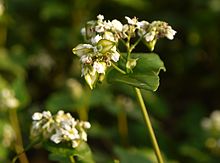**Buckwheat Overview**:
– Etymology: Buckwheat’s name origins from its tetrahedral seeds resembling beech nuts, potentially from Middle Dutch words or native Dutch formation.
– Description: Buckwheat is an herbaceous annual plant with red stems, arrow-shaped leaves, and achenes with 3 sharp angles.
– Distribution: Native to south-central China and Tibet, buckwheat has spread to suitable climates across Eurasia, Africa, and the Americas as a pseudocereal.
– History: Originating in southwestern China around 6th millennium BCE, buckwheat was domesticated in Southeast Asia before spreading to Central Asia, Tibet, the Middle East, Europe, and North America.
– Cultivation: Buckwheat is a short-season crop suitable for low-fertility or acidic soils, requiring well-drained soil and pollinators, with a growing period of 10-12 weeks.
**Production and Uses**:
– World Production: In 2022, global buckwheat production was 2.2 million tonnes, led by Russia (55%), followed by China (23%) and Ukraine (7%).
– Agricultural Benefits: Buckwheat is used as a pollen and nectar source to control crop pests, contributing to increased natural predator numbers.
– Functional Foods: Buckwheat contains phytochemicals like rutin, tannins, and fagopyrins, with low levels of inorganic arsenic, and aromatic compounds contributing to its unique aroma.
– Nutritional Value: Rich in protein, fiber, B vitamins, and minerals, buckwheat provides 1,440 kJ of energy per 100g, with a composition of 72% carbohydrates, 13% protein, and other essential nutrients.
– Gluten-Free and Adverse Effects: Buckwheat is safe for individuals with gluten-related disorders but may cause severe allergic reactions or phototoxicity in some cases.
**Research and Analysis**:
– Entomological Studies: Research on habitat management, conservation of natural enemies, and challenges for sustainable agriculture, including the study of buckwheat flowers on leafroller parasitoids.
– Nutrition and Health: Studies on daily nutrition values, dietary intakes, phenolic content in cereals, and extraction methods for rutin and fagopyrins from buckwheat seeds.
– Chemical Analysis: Research on the distribution of selenium and phenolics in buckwheat, isolation of fagopyrins, aroma components, and gluten-free diet applications.
**Allergies and Phototoxicity**:
– Buckwheat Allergy: Buckwheat can trigger severe allergic reactions, including anaphylaxis, with symptoms like skin rashes and digestive issues, requiring avoidance of buckwheat products.
– Phototoxicity: Fagopyrins in buckwheat can cause phototoxic reactions, leading to skin issues upon sunlight exposure, necessitating proper processing methods and limited intake for sensitive individuals.
**Utilization and Cultural Significance**:
– Utilization Potential: Buckwheat, a pseudocereal, offers high protein and fiber content, used in various recipes like noodles and pancakes, particularly popular in gluten-free cooking.
– Traditional Medicine: Buckwheat husk pillows are used in some cultures, though they may contain allergens, requiring proper cleaning for reduced allergen exposure.
– Historical Significance: Buckwheat has been a staple food in various cultures, introduced to America during colonial times, commonly used in early American cuisine, and studied for its grain properties and significance in certain regions.
Buckwheat (Fagopyrum esculentum) or common buckwheat is a flowering plant in the knotweed family Polygonaceae cultivated for its grain-like seeds and as a cover crop. Buckwheat originated around the 6th millennium BCE in the region of what is now Yunnan Province in southwestern China. The name "buckwheat" is used for several other species, such as Fagopyrum tataricum, a domesticated food plant raised in Asia.
| Buckwheat | |
|---|---|

| |
| Scientific classification | |
| Kingdom: | Plantae |
| Clade: | Tracheophytes |
| Clade: | Angiosperms |
| Clade: | Eudicots |
| Order: | Caryophyllales |
| Family: | Polygonaceae |
| Genus: | Fagopyrum |
| Species: | F. esculentum
|
| Binomial name | |
| Fagopyrum esculentum | |
| Synonyms | |
| |
Despite its name, buckwheat is not closely related to wheat. Buckwheat is not a cereal, nor is it even a member of the grass family. It is related to sorrel, knotweed, and rhubarb. Buckwheat is considered a pseudocereal, because its seeds' high starch content allows them to be used in cooking like a cereal.
